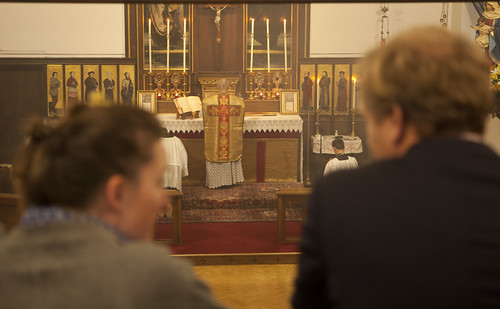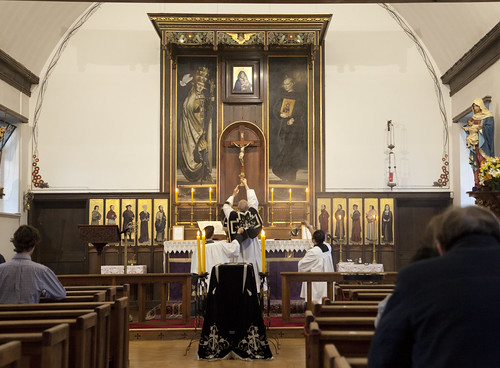Chairman's Blog
The Traditional Mass and Diversity
 |
| Venerating Our Lady of Walsingham at the end of the LMS Walking Pilgrimage in August this year. |
In a recent article in the Illinois Times, Massimo Faggioli, a theology professor at Villanova University in Philadelphia, is quoted as follows, of a specific Traditional Mass location:
It’s not an accident that all of these Catholics at the old Mass are white, because one of the things that happened after Vatican II was an ‘inculturation’ of the liturgy. …The Latin Mass is white and European by its definition, because it’s a product of the Catholic Church of the 16th century. So, this is creating serious problems because it is never limited to the liturgy only, but it is always the first step to saying Vatican II was a disaster.
I would far rather ignore these childish accusations, but I fear that if they are repeated frequently enough without rebuttal they will become established as part of the liberal narrative about the Traditional Latin Mass. But in order to shoe-horn the movement for the ancient Mass into the role of the bad guys in some racially-charged political confrontation, Faggioli needs to distort the past and ignore the present. Let’s start with the past.
Read the whole thing there.
New edition of the FIUV's magazine: Gregorius Magnus 12, Winter 2021
Reactions to Traditionis CustodesFrom members' magazines: Peter Kwasniewski on proclaiming the Gospel to the north; Pope Francis and Dante; Remembering Mgr Richard Soseman; Cardinal Merry del Val.Features: J.R.R.Tolkien by Robert Lazu Kmita; Traditional walking pilgrimage in Spain.50th Anniversary of the English Indult; Petitions from 1966 to 1997.
Support the Latin Mass Society
Part time job vacency in the LMS
The Latin Mass Society is unique among Una Voce groups around the world in having a permanent office and paid staff. Above is a picture of our office which I took when we moved into it (from a smaller one) in 2009. It is big enough to have volunteers working in part of it, and for schola rehearsals in the evenings and vestment mending on Saturdays. It located in Holborn, London's theatre district, not far from Corpus Christi Maiden Lane.
We have two full-time members of staff, two freelancers (our publicist and our magazine editor), and, usually, a part-timer. Our previous part-time employee is moving to Canada, so we need to replace her.
Details below.
The Latin Mass Society has a vacancy for a part-time Office Assistant, based in Holborn.
KEY AREAS OF RESPONSIBILITY
Office administration - The Office Assistant acts as the principal secretary for the LMS office. This includes general correspondence, answering telephone calls, post and emails.
Membership administration - The Office Assistant is responsible for the membership database (CiviCRM), membership renewals, data entry, data analysis, data export (print or email mail-merges).
Mail-order - The Office Assistant is responsible for the administration of the LMS online shop (Drupal Commerce). This includes stock replenishment, stock management, product updates/additions and order fulfilment (picking, packing & mailing).
Information administration - The Office Assistant is responsible for compiling information which pertains to the Charity, including research and document publication and distribution.
Volunteer administration – The Office Assistant is responsible for overseeing office work undertaken by volunteers.
Other tasks as determined by the General Manager.
The full job description and details of the application process can be found here. Closing date for applications is Friday 22nd October 2021.
LMS Pilgrimage to Oxford, 11am Sat 16th October, Blackfriars
At 11am the Dominicans will be celebrating for us a High Mass in honour of the Martyrs of Oxford University. It will be accompanied with Dominican chant and polyphony.
Online stole making course from the Guild of St Clare, 30th October
 |
| An 'off line' Guild event |
Photos Masses in Oxford
We had two Sung Masses last week: for St Michael the Archangel, and a Requiem for someone who died during the Coronavirus epidemic. Both were accompanied with polyphony directed by Dominic Bevan.
With thanks to Fr John Saward, priest in charge, and the multitasking MC Richard Pickett.
Support the Latin Mass Society
New Guild of St Clare video: a large patch
Support the Latin Mass Society
Students protest about Christian conference
The fact that the event had taken place at all only became known to the college’s radicalized students when one of them found a flyer from the event lying around. Since the students were not in residence at the time, they missed the chance to be upset by hearing any of the talks or discussions, or traumatized by meeting any of the attendees. They had to make do with their distress at the fact that the college’s hallowed meeting rooms and corridors had felt the presence of a wider range of views than has become usual.
Read the whole thing there.
Server training and vestment mending at Spanish Place
Our activities at St James' Spanish Place were jolly affairs as usual on Saturday, and well attended. The Guild of St Clare vestment making and mending was in the basement, and the Society of St Tarcisius server training was in the church upstairs.
Fr Andrew Southwell, a priest of Southwark Archdiocese familiar from the St Catherine's Trust Summer School who has been in Rome doing studies but is currently in London, was able to enroll five new members of the Society of St Tarcisius, including a Senior MC, who is our MC at the Monday evening Masses in Corpus Christi Maiden Lane.
We have another such event booked, on Saturday 20th November: what you need to know is here (for servers) and here (for the vestment mending).
Support the Latin Mass Society
Who’d like to talk about Socrates?
Socratic Seminars: October 2021
I am returning to these after a break over the Summer. I have been doing them since January 2021 and have an established pattern, alternating different dialogues to discuss in a series of four seminars.
The idea is that these are open to anyone over 16, regardless of prior knowledge, and take place on line, for a modest fee. The early dialogues are works of real philosophical value but presented in a way designed (I imagine) to engage people without prior training: they are the training. These seminars have been satisfying for me and have engaged the interest of a range of participants: at any rate they tend to come back for more.
This round the following are on offer:
For beginners:
Series 2: Apology (on Socrates' mission), the Crito (on political obligation), Charmides (on temperance), and Hippias Minor (on voluntary wrongdoing).
Intermediate (for those who've done either or both of the introductory series of seminars 1 and 2):
Series 4: Protagoras (virtue and its teachability) and Gorgias (oratory and justice), each divided into two parts.
More advanced (for those who’ve done either or both of the intermediate series of seminars, 3 and 4):
Series 6: Symposium (on eros) and Parmenides (on the Forms), each divided into two parts.
I teach on Thursdays, we find a time convenient to each person in each seminar. Numbers between two plus plus me to five plus me.
I hope to start on Thursday 7th October.
Email me to register your interest. Joseph.shaw99 AT gmail.com
More information can be found here.














